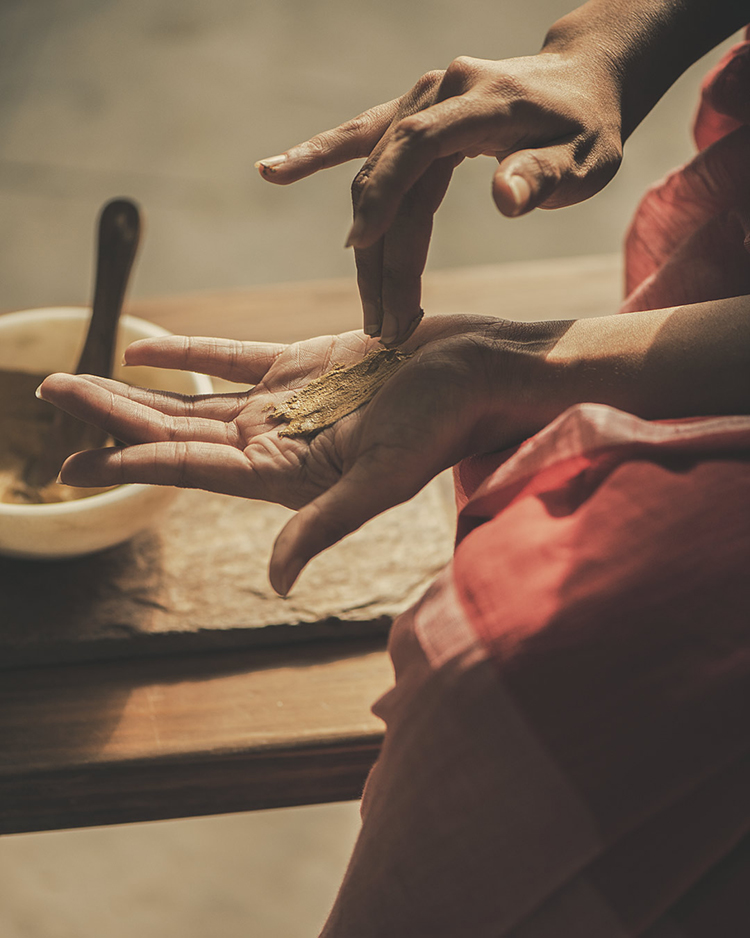



Chandan or Sandalwood has been prized since antiquity in India. Its cooling, scented paste is used to adorn the gods by Hindus. And Sandalwood essential oil is one of the most enduringly popular ones in both perfumery and Aromatherapy

Long before I qualified as an aromatherapist and became the resident Aromatherapy consultant at Paro New Delhi, I took a personal trip to Southern India and travelled through Tamil Nadu, Kerala and Karnataka in search of the rare and expensive liquid gold better known in these parts as Sandalwood. A particularly fond memory was the first time I smelt real Sandalwood. Browsing idly in the myriad of markets strewn across vibrant Chennai, I was drawn to a colourful shop, emitting from every corner of its existence an amazing woody, grounding, meditative scent so divine that I wanted to bathe and anoint my soul with its harmonizing aroma. Drawn by this rich, heavy sensual scent, I picked up an intricately carved wooden figure, of a Nandi bull, instinctively I brought it to my nose and inhaled its intoxicatedly beautiful aroma. The Sandalwood essential oil that was still present in this piece of carved art emitted from its soul even after being harvested, carved and displayed on a shelf for months or even years. Such is the power and longevity of some of nature’s spiritually heightened natural essential oils. I felt emotionally balanced and at peace for the first time during my hectic journey through the south of India in what could be described as the very hectic and dramatic urban sensory overload.
Sandalwood has been used from the earliest times, being mentioned in Sanskrit manuscripts. It also appears in one of the oldest pieces of Indian literature, the Ramayana (c. 2,000 BC) and in the Nirukta, the oldest Vedic commentary known. The ancient Egyptians imported Sandalwood and used it in medicine, embalming and ritual burning to venerate the gods. The Egyptians also used Sandalwood as a perfume and an ingredient in many cosmetics. In Buddhism Sandalwood is considered to be one of the three incenses integral to Buddhist practice, together with Aloes wood and Cloves. In Zoroastrian temples Sandalwood was burned to soothe the troubles of humanity. Sandalwood is one of the perfumes approved by Islamic tradition, which also includes Musk, Amber, Jasmine and Myrrh. Muslims use the raw wood to burn as incense and the oil as perfume for the Eid-al-Fitr holiday which ends in Ramadan.
As one of the few woods immune to attack by white ants, the heartwood (the innermost part of the tree stem) from Sandalwood trees was widely used in building, particularly temples. Sandalwood has some 15 different names in various Indian languages, Chandan being the Hindi name. Sandalwood is believed to be scented by the gods and Hindus consider the Heartwood sacred. Sandalwood is thought to emit spiritual vibrations of a highly evolved nature and is thus ideal for use in worship and meditation. Hindu legend says that when Shiva performed the cosmic dance in his Nataraja manifestation, the sweat droplets that fell from his body took form as seeds from which the Sandalwood trees sprouted. Even today most Hindu homes in India have a piece of Sandalwood which is ground on a stone plate sprinkled with water, and the resulting paste is applied to the foreheads of idols as an offering during puja (worship).
As the Sandalwood tree grows, the essential oil develops in the roots and heartwood. The tree reaches full maturity after 60-80 years. The scent of Sandalwood is stronger and the value of the wood much higher the longer one waits to harvest the tree. Traditionally, a tree was not considered to be worth cutting down until it was at least 60 years old. Today, in order to protect its dwindling stock of Sandal trees, the Indian Government has placed a ban on the felling of trees less than 30 years old. However, greed has led many to cut immature trees as young as 15 years old, and this has led to the current shortage of Sandalwood.
Both the heartwood and the roots of the Sandal tree are fragrant and contain oil, but the bark and sapwood are odourless. The Sandalwood tree is never cut down, but uprooted during the rainy season, when it is richer in the precious essential oil. The trunk is usually left on the ground for several months for the white ants to eat away the sapwood; it is then trimmed and sawn into billets 2-2½ feet long and taken to mills, where it is again trimmed and sorted into grades. Sandalwood essential oil is water or steam distilled from the heartwood and roots, with a mature tree yielding around 60 kilos of oil. Once the oil has been distilled it is left for six months so that it can achieve the right maturity and perfume. It develops from a very pale yellow colour to a brownish yellow.
In terms of its therapeutic properties Sandalwood is highly nourishing for the skin, spirit and soul. It is a powerful rejuvenator, analgesic, antidepressant, anti-inflammatory, antiseptic (urinary and pulmonary), antispasmodic, aphrodisiac, astringent, carminative, cicatrisant, diuretic, expectorant, sedative and tonic. In other words, it is a powerhouse of benefits.
Mind & Spirit
Sandalwood has a calming effect and is useful for dealing with the stresses of a busy life as Sandalwood helps to reduce tension, deals with nervous depression, anxiety, stress and confusion. Being quite a heavy oil, it is more sedative than uplifting and is useful for treating insomnia, particularly where this is caused by worry. It is thought to have the ability to ground us and connect us with the earth, to still the mind and allow our creativity and higher consciousness to flower. It has long been considered an important meditation aid as it calms the mind, stills ‘mental chatter’ and aids in the opening of the ‘Third Eye’. Sandalwood also opens us up emotionally and helps us accept others and to receive love, warmth and understanding. It is also widely known to be an excellent aphrodisiac.
Add 4 drops of Sandalwood oil (no need to blend with other oils) to a diffuser in the bedroom an hour before retiring to bed. The room will be filled with a delicious aroma instilling peace, calm and ultimately balance.

Sandalwood has a calming effect and is useful for dealing with the stresses of a busy life as Sandalwood helps to reduce tension, deals with nervous depression, anxiety, stress and confusion…
Body
Sandalwood is recognised as having a pronounced effect on the genito-urinary tract and is therefore useful in treating urinary tract infections. It is also a good pulmonary antiseptic and is very effective for coughs, particularly dry persistent ones, and for chronic bronchitis and sore throats. Sandalwood is also considered a digestive aid as it relieves intestinal spasm and inflammation, and can be useful in treating diarrhoea, Irritable Bowel Syndrome and colic.
Add 8 drops of Sandalwood essential oil to 20 ml of Jojoba oil, Almond Oil or Moringa and massage all over the body post shower or as a massage oil.
Skincare
It is excellent for dehydrated skin and relieves itching, inflammation and burning sensation. As a mild astringent, it can also be used for oily skin conditions. Sandalwood is used extensively in high-class perfumery as it is an excellent base and fixative for other perfumes. By itself, it has a deep yet mild, long-lasting sweet aroma, but the perfume industry finds that Sandalwood oil can blend well with other perfumes and does not impart its fragrance when used as a base.
Add 8 drops of Sandalwood essential oil to 20 ml of Marula, Moringa, Jojoba, Argan or Almond Oil and apply to the face. Remember, that less is more in this case.
Subtle uses
Powerful when used in meditation, Sandalwood stills the conscious mind and allows one to enter into deep states of meditation and visualisation. The yogis describe Sandalwood oil as the fragrance of the ‘subtle body’, the centre of highest insight and enlightenment.
The oil has an affinity with the Base Chakra and also works at the level of the Crown Chakra in facilitating spiritual development. It links these two chakras, reminds us that chakra energy forms a circuit and helps us to understand the unity of mind and body. Like the oils of Jasmine and Rose, Sandalwood also connects the Sacral, Heart and Crown Chakras, symbolising the spiritual dimension of sexuality.
Place three drops of Sandalwood on a handkerchief and enjoy its aroma throughout the day when feeling ill at ease or out of balance and the need to ground yourself emotionally.
On the other hand, Sandalwood also has an affinity with and blends perfectly well with Frankincense, Cedarwood, Patchouli, Rose, Lavender, Geranium, Orange and Lemon. When forming a synergy with other essential oils the power of the blend is heightened, providing multiple health and wellbeing benefits.
Essential oils become airborne as soon as they come into contact with the atmosphere. Vaporizing or burning oils is a pleasant but sure way of improving your overall mood and wellbeing. Besides the wonderful effects of inhalation, you will also have a flow-on effect on a physical level as the essential oils are absorbed into the bloodstream via the nose and lungs. This added benefit is particularly beneficial for those suffering from emotional imbalances brought on by stress or associated health conditions that tend to be a symptom of an emotional state such as anxiety, fear of failure in bed, poor self-esteem and lack of confidence in relationships.
Add 2 drops of Sandalwood, 1 of Vetiver (Khus) and 1 of Lemon to the water in a diffuser. Then sit back and let emotional balance, calm and the feeling of being totally grounded return to your being.

As the Sandalwood tree grows, the essential oil develops in the roots and heartwood. The tree reaches full maturity after 60-80 years. The scent of Sandalwood is stronger and the value of the wood much higher the longer one waits to harvest the tree.
Using Sandalwood in a blend can be emotionally strengthening and alleviate anxiety caused by physical and emotional overload. Sandalwood when combined with Frankincense and Neroli also can help in the grieving process of getting over the loss of a loved one. Using essential oils in a warm bath is enjoyable and a very effective way to get the body back into equilibrium. This is because the blended oils can act in two ways; through absorption into the skin and via inhalation, as the warm water causes evaporation of the essential oil. For a bath that offers emotional strength and nourishes the skin a lady should add 3 drops of Geranium, 3 drops of Patchouli and 3 of Sandalwood. A gentleman should use 3 drops of Sandalwood, 3 drops of Vetiver (Khus) and 2 of Cardamom. For grief and over-coming loss add 3 drops of Sandalwood, 3 drops of Neroli and 3 drops of Frankincense.
Essential oils used in a bath must first be mixed with a dispersant, for example a teaspoon of sweet Almond oil, full fat Milk or Alcohol. If you have dry or sensitive skin, add the essential oils to a greater amount of carrier oil like Jojoba, Avocado or Wheatgerm and then add to the water. Stay in the water for 20 minutes (These blends are only for adults over 18 years of age. Pregnant women and elderly people should use half the dose).
Add 8 drops of essential oil to 20 ml of carrier oil and place in a dark bottle with the top firmly fastened. For females I would recommend 3 drops of Rose, 2 drops of Sandalwood and 2 of Ginger. For males try 3 drops of Sandalwood, 2 drops Ginger, 2 drops of Vetiver and finally 1 drop of Black Pepper. A massage with these blends will assist the passage of the oils into the body and to the areas of emotional and spiritual wellbeing, whilst relaxing the muscles, enabling the blood and lymph to flow more freely and soothe the mind.
For immediate effect, sprinkle 2 drops of Sandalwood, 2 drops of Vetiver and 1 drop of Lemon pure essential oil on to a tissue. Inhale deeply three times. If you do not have an Aromatherapy burner and are worried about using naked flames in the home add the same blend in the exact quantity to a basin of warm water, letting the vapors fill the room with balancing aromas. Finally, and the most effective and undisturbed way to prepare the room for balance is to add 2 drops of Ylang Ylang, 2 drops of Sandalwood and 2 drops of Rose essential oil to water in an Aromatherapy burner (with tea light candle alight) or better still an electric diffuser. Caution: never leave candles burning unattended.
The burner can be prepared 15 minutes before sleep. Imbalances will flow out from your being even as you rest and sleep. Enjoy and harness the power of Sandalwood alone or in a blend which can specifically target any imbalances within the body and restore you with health and wellbeing.
The Sandalwood tree (Santalum album) is diminishing in abundance due to over-enthusiastic cutting and poor management of stocks. This shortage, together with the fact that so much sandalwood oil comes from trees cut by criminal gangs who show little respect for nature, has led many aromatherapists to call for therapists to stop buying Sandalwood oil. This seems a little extreme to me, as it is important to note that Sandalwood is not in imminent danger of extinction. It has been over-harvested to be sure, and is being belatedly replanted, but since these trees will not be ready to yield their oil for another 30-40 years, we could be facing a prolonged and possibly severe shortage of genuine Sandalwood. This will lead to price rises, and Sandalwood could become as costly as Jasmine or Rose oil.
In future, each aromatherapist will have to decide for themselves whether they wish to continue to use Sandalwood (santalum album), or whether the best alternative, Santalum spicatum, from Austrailia is acceptable to them. Devotees of Sandalwood will need to make sure that they buy from reputable, ethical suppliers who can demonstrate the genuine purity of their product, and that it has been obtained from a legal, traceable and sustainable source. Perhaps a shortage of Sandalwood might, in the long run, be beneficial, as it could lead us to treat Sandalwood with greater respect, and begin to accord the tree and its oil, with its beautiful aroma and healing, spiritual qualities, the respect and reverence it has commanded throughout history.